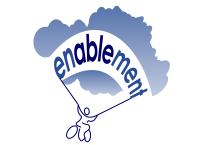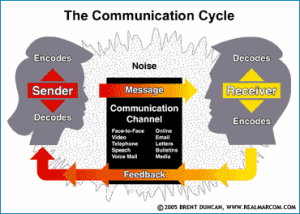Communication and Children with Cerebral Palsy: Difference between revisions
Michelle Lee (talk | contribs) mNo edit summary |
Michelle Lee (talk | contribs) No edit summary |
||
| Line 65: | Line 65: | ||
<br> | <br> | ||
Here are some examples of specific problems that some children with CP can have when communicating: | Here are some examples of specific problems that some children with CP can have when communicating: | ||
Floppy children: | Floppy children: | ||
*These children can have problems speaking with a clear voice, because the muscles of the trunk are weak and this influences also the loudness of the speech. | *These children can have problems speaking with a clear voice, because the muscles of the trunk are weak and this influences also the loudness of the speech. | ||
| Line 75: | Line 75: | ||
*They will have problems with understanding as well | *They will have problems with understanding as well | ||
If children who have problems with speaking are not given an alternative to speech, they may have difficulty sending a response, and the communication cycle will break down. <br>[[Image: | If children who have problems with speaking are not given an alternative to speech, they may have difficulty sending a response, and the communication cycle will break down. <br>[[Image:Communication cycle.png|center|600x450px]] | ||
=== | === Developing Communication Skills === | ||
There are many different ways to influence and develop communication skills in children with CP, here are some ideas of games to help improve mouth control: | |||
*Imitate a chicken by keeping a "worm" between the lips (not between the teeth!). How long can you hold it (make a game who is the champion). | |||
*Making funny noises. e.g. the noise of a starting car or motor bike. | |||
<br> | *Blow a kiss. | ||
*Imitate the wailing siren of a police care: u-i-u-i | |||
*Clicking the tongue, fast and slow, like the sound of a horse on the road. | |||
*Make the tip of the tongue like a tower and stick it out of the mouth as far as possible | |||
*Try to touch the nose, cheek and chin with the tongue. Who is doing best? | |||
*Inflate a balloon (or imitate it). | |||
*Make funny faces, using all parts of the face (you can also use a mirror) | |||
*Try to blow a pingpong ball or a piece of cottonwool away: who is the best? Can you blow further than last week?<br><br> | |||
[[Category:Cerebral_Palsy]] | [[Category:Cerebral_Palsy]] | ||
Revision as of 21:32, 20 August 2016
Top Contributors - Michelle Lee, Naomi O'Reilly, Kim Jackson, Laura Ritchie, Tarina van der Stockt, Admin, Simisola Ajeyalemi, Evan Thomas, Lauren Lopez and Olajumoke Ogunleye
Introduction [edit | edit source]
The information on this page has developed for you from the expert work of Roelie Wolting alongside the Enablement Cerebral Palsy Project and Handicap International Group.
Communication[edit | edit source]
Communication occurs when a sender transmits a message and a receiver understands the message. An effective communicator independently alternates as a sender and a receiver regardless of the demands of a conversation, including settings (e.g., community, school, work, home), conversational partners, and topics. All methods of communication performance are considered in determining the CFCS level. To find out more about the GFCS have a look at this page.
Methods and Challenges of Communication [edit | edit source]
Here are a list of methods of communication and what challenges a child with cerebral palsy may come across:
| Method | Challenge |
|
Speaking |
Coordination of mouth and tongue muscles/ people do not listen to them |
|
Listening |
Concentration |
|
Writing |
Fine motor skills |
|
Showing / pointing at pictures |
Fine motor skills / hand - eye co-ordination |
|
Making gestures / sign language |
Fine motor skills / motor planning |
|
Body language / facial expression |
Muscle control of body / face |
Here are some examples of specific problems that some children with CP can have when communicating:
Floppy children:
- These children can have problems speaking with a clear voice, because the muscles of the trunk are weak and this influences also the loudness of the speech.
Children with complex disabilities (CP and Intellectual disability):
- They will have problems with understanding as well
If children who have problems with speaking are not given an alternative to speech, they may have difficulty sending a response, and the communication cycle will break down.
Developing Communication Skills[edit | edit source]
There are many different ways to influence and develop communication skills in children with CP, here are some ideas of games to help improve mouth control:
- Imitate a chicken by keeping a "worm" between the lips (not between the teeth!). How long can you hold it (make a game who is the champion).
- Making funny noises. e.g. the noise of a starting car or motor bike.
- Blow a kiss.
- Imitate the wailing siren of a police care: u-i-u-i
- Clicking the tongue, fast and slow, like the sound of a horse on the road.
- Make the tip of the tongue like a tower and stick it out of the mouth as far as possible
- Try to touch the nose, cheek and chin with the tongue. Who is doing best?
- Inflate a balloon (or imitate it).
- Make funny faces, using all parts of the face (you can also use a mirror)
- Try to blow a pingpong ball or a piece of cottonwool away: who is the best? Can you blow further than last week?










